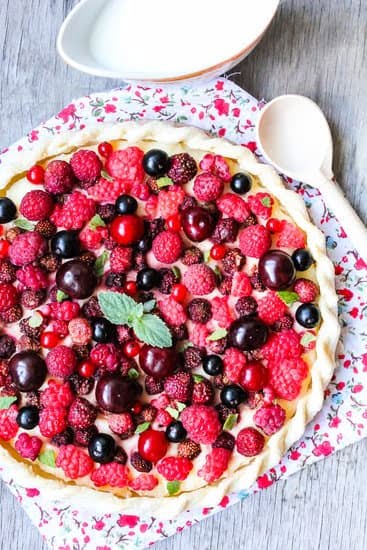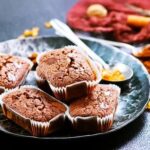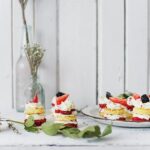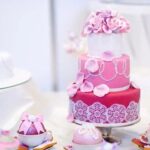Are you looking to elevate your baking skills and learn the art of simple decorating cake? Decorating cakes can be a fun and fulfilling experience, allowing you to showcase your creativity and impress your friends and family with beautifully adorned treats. Whether you’re a beginner or want to improve your skills, this comprehensive guide will provide you with all the essential tools, techniques, and creative ideas for creating stunning cake decorations.
Decorating cakes is not just about making them visually appealing; it also adds an extra layer of flavor and texture to the overall baking experience. A well-decorated cake can turn any ordinary dessert into a show-stopping centerpiece at any celebration. From birthdays to weddings, a beautifully decorated cake can bring joy and create lasting memories for everyone involved.
In this article, we’ll cover everything you need to know to get started on your journey to becoming a skilled cake decorator. We’ll discuss essential tools and ingredients, step-by-step guides on leveling and frosting cakes, creative decoration ideas for beginners, basic piping techniques, using edible flowers and fruits for decoration, as well as tips for achieving professional-looking results. Let’s dive in and discover the wonderful world of simple yet beautifully decorated cakes.
Essential Tools and Ingredients for Decorating Cakes
When it comes to simple decorating cakes, having the right tools and ingredients is essential for achieving professional-looking results. From basic frosting techniques to more advanced decoration ideas, having a well-stocked kitchen and the right equipment can make all the difference in your cake decorating endeavors.
Essential Tools
To decorate a cake, you will need some basic tools such as an offset spatula for spreading and smoothing frosting, a turntable for easy maneuvering of the cake while frosting, a bench scraper for creating smooth sides, and piping bags and tips for adding decorative elements. Other helpful tools include a cake leveler for creating even layers, a cake lifter for transferring finished cakes, and a small offset spatula for precision work.
Key Ingredients
The key ingredients for decorating cakes include ready-to-use fondant or gum paste for sculpting decorations, food coloring gels or powders to add vibrant color to your creations, and various sprinkles or edible decorations for adding texture and visual interest. Additionally, having a good quality buttercream or royal icing is important for smooth frosting and intricate piping work.
Additional Tips
In addition to having the right tools and ingredients on hand, it’s important to ensure that they are of high quality. Investing in professional-grade equipment and using fresh, high-quality ingredients can elevate the overall look and taste of your decorated cakes.
It’s also important to have a clean and organized workspace when working on cake decorations as this can impact the final result. By ensuring you have the essential tools and ingredients at your disposal, you’ll be well-equipped to create beautifully decorated cakes right at home.
Step-by-Step Guide on How to Level and Frost a Cake
Leveling and frosting a cake is an essential skill for any aspiring baker or cake decorator. Whether you’re making a simple decorating cake for a special occasion or just want to indulge in some baking therapy, knowing how to achieve the perfect base for your cake decoration is key. Here’s a step-by-step guide on how to level and frost a cake like a pro.
Leveling the Cake
The first step in preparing your cake for decoration is to level it. To do this, start by placing your cooled cake on a flat surface. Use a long serrated knife to carefully slice off the domed top of the cake, ensuring that it is level and even. This will provide a smooth and stable surface for frosting.
Frosting the Cake
Once your cake is leveled, it’s time to apply the frosting. Begin by placing a dollop of frosting on the center of your cake stand or serving plate to secure the cake in place. Then, using an offset spatula, spread a layer of frosting over the top of the cake. For multi-layered cakes, continue to stack and frost each layer before moving on to the sides.
Creating Smooth Surfaces
To achieve perfectly smooth surfaces on your frosted cake, use an icing smoother or bench scraper. Hold it against the sides of the cake at a 45-degree angle and gently rotate the turntable while smoothing out any bumps or ridges in the frosting. Continue this process until both the top and sides of your cake are smooth and even.
With these simple steps, you’ll be able to confidently level and frost your cakes with ease, creating a flawless canvas for your creative decorating ideas.
Creative Cake Decoration Ideas for Beginners
So, you have successfully leveled and frosted your cake, now it is time for the fun part – decorating. Here are some creative cake decoration ideas for beginners to help you get started:
- Simple designs: Start with simple designs such as polka dots, stripes, or swirls. These are easy to achieve and can add a pop of color and visual interest to your cake.
- Use edible sprinkles or nonpareils: Sprinkling colorful edible sprinkles or nonpareils over your frosted cake can instantly elevate its appearance. You can create patterns or simply cover the entire surface for a festive look.
- Try chocolate ganache drips: Dripping chocolate ganache down the sides of your cake gives it a professional and elegant touch. It’s a simple yet impressive decoration that will wow your guests.
In addition to these ideas, basic piping techniques can also take your cake decorating skills to the next level. With some practice, you can create beautiful designs using just a piping bag and different tips.
Basic Piping Techniques for Decorating Cakes
Once you have mastered the art of leveling and frosting a cake, it’s time to explore basic piping techniques to take your cake decorating skills up a notch. Whether you want to write personalized messages on cakes or create intricate designs, piping is an essential skill for any aspiring baker.
Here are some basic piping techniques that every beginner should learn:
- Border piping: Use a round tip to pipe decorative borders around the top and bottom edges of your cake. This simple technique adds a polished look to your creation.
- Rosettes: With a star tip, you can easily create beautiful rosettes by applying consistent pressure while swirling the icing in a circular motion. These rosettes make for stunning focal points on cakes.
- Writing: Practice writing with icing using different lettering styles and sizes. Personalized messages add a thoughtful touch to any cake.
With these basic piping techniques under your belt, you’ll be well on your way to creating beautifully decorated cakes that will impress friends and family alike. The key is practice, so don’t be afraid to experiment with different designs and get creative with your decorations.
Basic Piping Techniques for Decorating Cakes
Piping techniques are an essential skill for anyone looking to decorate a cake. Whether you’re working with buttercream, royal icing, or fondant, mastering the art of piping can take your simple decorating cake to the next level. Here are some basic piping techniques that beginners can practice and perfect:
- Shell Piping: This classic technique creates a beautiful border or design on the edge of the cake. Simply hold the piping bag at a 45-degree angle and squeeze the icing out in a quick, back-and-forth motion.
- Swirls and Rosettes: These techniques are perfect for adding a decorative touch to cupcakes or cakes. Start in the center and pipe in a circular motion to create a beautiful swirl or rosette effect.
- Writing: Practice piping letters and words onto parchment paper before attempting to write directly on the cake. Use steady, even pressure to ensure smooth and legible lettering.
When practicing these basic piping techniques, be sure to use the right consistency of icing for best results. A thicker icing is ideal for creating borders and outlines, while a thinner icing is better suited for filling in designs and writing.
Remember, practice makes perfect when it comes to piping. Don’t be discouraged if your first attempts aren’t flawless – with time and patience, you’ll soon be creating beautifully decorated cakes with confidence and skill.
Overall, learning basic piping techniques is an exciting step towards mastering the art of cake decorating. With dedication and practice, you’ll soon be able to create stunning designs that will impress friends and family alike with your simple decorating cake skills.
Using Edible Flowers and Fruits for Cake Decoration
One of the easiest and most beautiful ways to decorate a simple cake is by using edible flowers and fruits. Not only do they add a pop of color to your dessert, but they also provide a natural and fresh touch that can elevate any basic cake to a stunning masterpiece. When choosing edible flowers, it’s important to select ones that are pesticide-free and safe for consumption.
Some popular options include roses, lavender, violets, and pansies. For fruits, consider using berries, citrus slices, or even tropical fruits like kiwi or mango.
When incorporating edible flowers and fruits into your cake decoration, it’s essential to consider the flavor combinations. For example, pairing lemon-flavored cakes with edible lavender or using chocolate cake as a base for raspberry and blackberry garnishes can enhance the overall taste experience. Additionally, you can infuse simple syrup with complementary flavors such as rose water or citrus zest to brush onto the cake layers before adding the fruits or flowers.
Another important aspect to keep in mind when decorating with edible flowers and fruits is the placement. Depending on the design you’re aiming for, you can strategically place larger blooms as centerpieces or create cascading effects with delicate petals around the edges of the cake. For fruit decorations, consider slicing them thinly and overlapping them in a pattern or placing them strategically on top of piped whipped cream or frosting for an elegant finish.
Finally, make sure to thoroughly wash and dry all edible flowers and fruits before using them for decoration. Remove any stems, leaves, or seeds that are not meant for consumption. It’s also advisable to refrigerate any leftover decorated cake if it contains fresh fruit to maintain its freshness.
| Edible Decorations | Flavor Combinations |
|---|---|
| Roses | Lemon-flavored cakes paired with lavender |
| Berries | Chocolate cake combined with raspberry and blackberry garnishes |
| Citrus Slices | Citrus zest-infused simple syrup brushed onto vanilla sponge cake layers |
Tips for Achieving Professional-Looking Cake Decorations
Decorating a cake can be a fun and rewarding experience, especially when the end result looks professional and beautiful. However, achieving a professional-looking cake decoration may seem daunting for beginners. But with the right tips and techniques, anyone can create stunning cakes at home.
One tip for achieving professional-looking cake decorations is to invest in high-quality decorating tools. This includes piping bags, piping tips, offset spatulas, and a turntable. These tools will make the decorating process much easier and help you achieve clean and precise designs on your cakes.
Another tip is to practice patience and attention to detail. Decorating a cake takes time and precision, so it’s important to take your time and pay attention to the small details. Whether you’re piping intricate designs or placing edible flowers on your cake, being patient and meticulous will result in a more professional-looking decoration.
Additionally, it’s important to have a plan for your cake decoration before you start. Whether you have a specific design in mind or you’re following a tutorial, having a clear plan will help you execute the decoration more effectively. Take the time to sketch out your design or gather inspiration from online resources before starting the decorating process.
By following these tips and techniques, anyone can achieve professional-looking cake decorations at home. With practice and the right tools, decorating a cake can be an enjoyable and fulfilling experience for bakers of all skill levels.
Conclusion
In conclusion, decorating cakes at home can be a fun and fulfilling activity for anyone, whether you’re a beginner or have some experience in baking. The importance of creating simple and beautifully decorated cakes cannot be understated, as it adds a personal touch to any celebration or gathering. With the right tools and ingredients, along with some basic techniques and creativity, anyone can learn to decorate a cake like a pro.
By following a step-by-step guide on how to level and frost a cake, beginners can quickly gain confidence in their decorating skills. Additionally, learning basic piping techniques and utilizing edible flowers and fruits for decoration can elevate the look of any homemade cake. It’s all about experimenting and finding what works best for each individual’s style.
Ultimately, achieving professional-looking cake decorations at home is not as difficult as it may seem. With practice and patience, anyone can master the art of simple decorating cake, adding their own personal flair to every creation. The satisfaction of seeing your friends and family enjoy your beautiful and delicious creations makes the effort all worthwhile. So go ahead, unleash your creativity in the kitchen and start decorating those cakes.
Frequently Asked Questions
How to Decorate Cake in Home Simple?
Decorating a cake at home can be simple if you start with a smooth frosting base. Using a piping bag with different tips, you can create various designs and patterns with buttercream or icing. Adding edible flowers, sprinkles, or chocolate shavings can also elevate the cake’s appearance.
How Do You Decorate a Cake Simply?
Decorating a cake simply can be achieved by using easy techniques like spreading the frosting smoothly with an offset spatula, then adding some decorative touches like fresh fruit, edible glitter, or even a dusting of powdered sugar. You don’t need intricate designs to make a cake look beautiful.
What Kind of Cake Is Easiest to Decorate?
The easiest type of cake to decorate would be one with a flat top, such as sheet cakes or round cakes that are leveled off. This makes it easier to spread the frosting evenly and add any decorations.
Additionally, cakes with smooth sides, like sponge cakes or chiffon cakes, are also easier to work with when it comes to decorating as they provide a clean canvas for designs and toppings.

Welcome to our cake decorating blog! My name is Destiny Flores, and I am the proud owner of a cake decorating business named Cake Karma. Our mission is to provide delicious, beautiful cakes for all occasions. We specialize in creating custom cakes that are tailored specifically to each customer’s individual needs and tastes.





